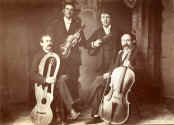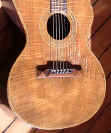| This is just too
amazing! This instrument has a story in two parts: First, the discovery of it in a rare, personal photograph, and the provenance provided by that. Second, the fact that it survived, not to mention the worldwide travels it endured, finally to be rediscovered! |
|
 |
Part 1. The incredibly intriguing
instrument came to light in August, 2002 from a photograph discovered in the Detlor collection (see
Historical Photos and Otto Anderson).
We are indebted to Jeanette's mother's careful note keeping - she
wrote on the back of the photograph "Made by O. E. Anderson for Knudson (sic)
Family, Port Townsend." She was unable to identify any of the musicians. The guitar definitely looks Knutsen-like: the bridge and body shape are identical to the early "Patent-style" harp guitars. But what happened to the bass arm? Even with the vast variety of Knutsen bass arm experiments, we've never seen one like this! The obvious question is whether Otto designed the arm variation, or did Knutsen dream it up and commission it? Tantalizing history, to be sure! The only instruments superficially similar to this are the later Mozzani guitars (see Similar Instruments), so this was another Knutsen-Anderson first. And for our ongoing "Who built what?" research - note the double-scallop again on the end of the fingerboard. Update, Spring 2006: I cou'dn't imagine this story getting any more amazing, until Jeanette discovered that Otto had built a second instrument identical to the first! See HGP25. |
 |
|
 |
Part 2. In Jan,
2004, Joe Vinikow, a Knutsen Archives visitor spotted the photo above
and forwarded it to friend Flip Breskin, a musician in Bellingham, WA.
She immediately emailed the Archives to report that she had in her
possession . . . this very instrument! The odds of something like this
are just unbelievable - and what an instrument for it to happen
to! So what can we now learn from the actual specimen? Flip tells us: "Tone is extraordinary. The face wood is some kind of hard wood, and the tone has a clarity I've never found elsewhere. The articulation makes a rapid sequence of notes so clear that each note stands out in clear definition. It's only moderately loud, and fairly lightly built. Ladder braced. Mahogany back, which was originally finished with a deep purple varnish to sort-of match the rosewood sides, but not with any artificial grain painted on. Just a flat color. I had a guy strip and refinish it around 1970, before I knew better. It has really dark rosewood sides, and a sparkly mystery wood on the front. Deep chestnut in color, with iridescent golden grain-ends waving through, like maple gets sometimes in the sunshine. I've never yet found anyone who knew what the wood was, and I've asked a lot of woodworkers. Front is bookmatched, back is one piece. There's a pretty little mother-of-pearl lyre set into the fingerboard at the first fret. The inlay job isn't as delicate as the pearl itself, and the inlay hole is oval (both the inlay and execution are classic Knutsen. Could he have done the fretboard work? - GM). And where has the guitar been for the last 100+ years? Flip continues: "I found the Twangoleum (the unusual "pet name" is explained below - GM) hanging in the window of an antique shop in Seattle, on Aurora Avenue in 1969. I nearly drove off the road! Unfortunately the window faced West and got hot in the afternoon. The only case was a green felt bag, and the instrument was pretty warped. Strung up with steel strings heavy enough to support the Brooklyn Bridge. The family who had sold it to the dealer said their father brought it home from Europe at the end of WWI! "It's had a few periods of being played a LOT. The "alligator tail" (good description of the wrap-around arm - GM) prevents it from being barred up the neck, and the intonation is off from the warp in the face. The saddle has been relocated to try to deal with the intonation. In 1973 I handed it, on permanent loan, to Andy Cohen, who was playing a lot on the street. We were both living in Syracuse at the time. He had fallen madly in love with it and eventually gave it its name. Thereafter, I got occasional missives describing their adventures, plus a huge poster touting "A. Morris Meltzer-Cohen, the Twangoleum King" complete with a great photo. He said, "There's only one of it, so I might as well be king of it." He played it on the street for years, and it did its job. Lots of people stopped! I had told Andy that if he were ever done with it, he should give it back. I had moved home to Bellingham, Washington state, right after I handed it to Andy. One night around 3 AM I got a phone call that began, "I'm done with it, and I've got it a ride." "Huh? What? Who?" Well, once we sorted out what "it" was, I learned that the Twangoleum was headed for Port Townsend, Washington. My benefactor stopped in Bellingham on the way to bring my baby back home. It's history with me has a lot of connections with Port Townsend. I think Richard Ruskin had it for a while next. He's a great player from Seattle. I have a vague recollection of Elizabeth Cotten playing it during one of her visits, during the late 1970s. It's gotten around!" Update, Summer 2005: I got the chance to photograph and play this important instrument when Flip loaned it to me to use on my Knutsen recording project. After we had it further restored and set-up by Kerry Char in Portland, I tried stringing it in nylon (assuming that gut strings were original), but found the tone pretty poor. As Flip had long had it strung with steel, I then tried silk & bronze strings, which sounded great, with a healthy amount of sustain. In any event, I was sorry to see it go! |
|
Click on a picture to
enlarge |
|


